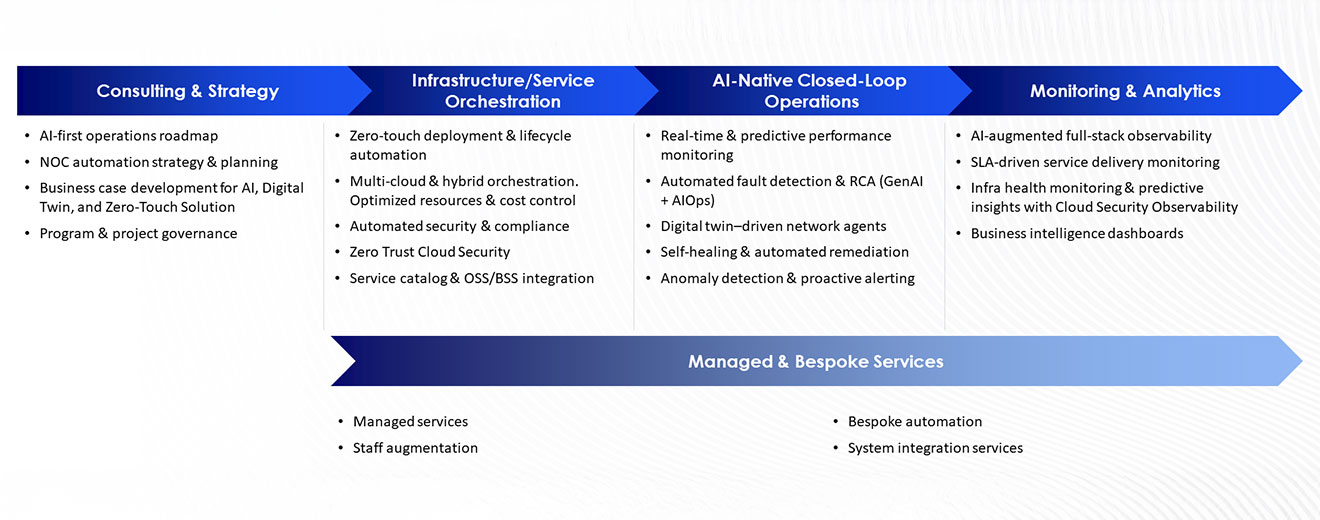

NEURON Wins Best Telco Orchestration Solution
Tata Elxsi's NEURON platform has been recognized as the Platinum Winner for 'Best Network Orchestration Solution in Telco' at Juniper Research's Future Digital Awards.
Read more

NEURON Wins at IMC 2024!
Tata Elxsi’s NEURON platform bags the “Most Innovative Telecom Software” award at India Mobile Congress 2024. A proud moment of innovation and excellence.
Read more

Cut Network Costs with Dark NOC
Discover how Tata Elxsi’s AI-powered Dark NOC can help telecom operators save millions through autonomous network operations and reduced energy use.
Read moreEmpowering the Next Generation of Autonomous Networks
As networks evolve with Infra, Cloud, 5G, Edge computing and IoT, telecom operators face growing complexity, rising operational costs and an urgent need for agility and reliability. Customers now expect seamless, always-on connectivity and personalized digital experiences while operators must balance performance, security, and compliance in a dynamic environment.
Tata Elxsi enables CSPs transform their network and cloud operations through AI-driven automation, and closed-loop assurance. From Telco Cloud automation and orchestration for VNF/CNF workloads to AI-powered observability and digital twins, we enable proactive optimization, predictive maintenance, and self-healing operations.
Tata Elxsi NEURON reduces TCO by 60% for a leading Telco in APAC
Business Challenge
With the proliferation of 5G SA, ORAN, edge sites, and multi-vendor cloud-native functions, operators are finding it challenging to maintain service levels using rule-based NOC workflows driving the need for closed-loop, AI-driven automation to handle real-time anomaly detection, root-cause correlation, and self-healing at scale.


Here’s How We Help
Network & Cloud Automation
- Telco cloud orchestration for 5G VNF/CNF workloads & Cloud-native security frameworks
- Cloud infra automation with Ansible, Terraform, Crossplane, GitOps & RedHat
AI-Driven Operations
- AI-powered closed loop operations with observability, digital twin & remediation
- RAN digital twin for predictive optimization & planning
Business & IT Process Automation
- IT workflow automation and migration to reduce manual overheads
- Business process automation for service agility & faster time-to-market
Service Framework

Use Cases
Dynamic Network Optimization
- AI-driven closed loops for real-time performance tuning
- Automated scaling across 5G and edge environments
- Improved QoE with proactive congestion management
Zero-Touch Service Provisioning
- Intent-based orchestration for faster rollout
- Automated configuration and activation
- Reduced manual errors and time-to-market
Predictive Maintenance & Security
- Continuous monitoring for anomaly detection
- Self-healing workflows to prevent outages
- Enhanced resilience and compliance visibility
Why Tata Elxsi?
- Seamlessly combining Consulting, System Integration, and Managed Services into a flexible and outcome-driven engagement model
- Partnership with leading hyperscalers and OSS vendors enables faster API integration and compliance-ready solutions
- Regulatory Alignment: Aligned with TSA (UK), TRA (MEA), GDPR and future-ready for AI policy frameworks
- Ready to deploy components including GenAI-enabled RCA engines, telemetry pipelines, and workflow automation kits
- AI/ML and Digital twin based framework for closed loop automation
- Intelligent process automation helped reduce MTTR by 40%, leading to a 60% increase in auto-closure of incidents
In Focus
Information Hub
-
How does the AI Telco Fabric achieve autonomous behavior?
Autonomous behavior is realized through closed-loop control systems. AI models interpret declarative intent and translate it into network policies. These policies are continuously enforced and refined based on real-time telemetry feedback, enabling dynamic configuration adjustments without manual intervention.
-
What is the role of AI agents within the network architecture?
The architecture employs distributed AI agents operating at both domain (e.g., RAN, transport, core) and service levels. These agents perform localized telemetry analysis, enforce domain-specific policies, and participate in a federated learning framework to exchange contextual insights. This ensures global policy consistency while preserving data locality.
-
How is network intent defined and enforced in real time?
Network intent is expressed as declarative policy statements that specify desired outcomes rather than procedural instructions. The orchestration layer interprets these policies, decomposes them into executable tasks, monitors for deviations, and dynamically updates configurations to maintain alignment with the declared intent.
-
How does the architecture ensure observability and explainability of AI-driven decisions?
The system maintains decision lineage by logging all AI-driven actions along with their corresponding input data, model outputs, and resulting configurations. This traceability enables operators to audit decisions, understand causal relationships, and validate the reasoning behind autonomous changes.
-
What mechanisms maintain stability during autonomous operation?
Stability is ensured through feedback loops governed by guardrails and confidence thresholds. Before applying AI-derived changes, the system performs pre-validation against performance metrics and policy constraints. This safeguards against unintended behavior and ensures operational reliability.
















